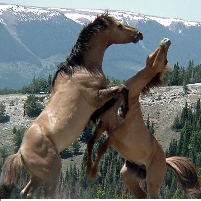Taming Wild Horses
Thursday, May 07, 2009
 Wild Horses in Montana
Wild Horses in Montana
Wild horses and burros have roamed the West for centuries, but the herds are quickly outgrowing their ranges. The amount of land available for wild horses to run and graze has fallen by about 20 million acres since the 1970s. The public ranges can no longer support the growing wild horse population. The strain on the environment causes damage to rangelands used by commercial ranchers, and displaces livestock and other wildlife.
A bill was approved last week by the House Committee on Natural Resources that would require the government to set up sanctuaries for the horses, outlaw killing the healthy ones, take steps to maintain wild horse population at a manageable size, and outlaw wild horse roundups using helicopters.
“The wild horse sanctuary would receive and care for some 30,000 wild horses currently in short- and long-term holding facilities, thereby saving the Bureau of Land Management, and the American taxpayer, approximately $700 million by 2020,” said Madeleine Pickens, wife of billionaire T. Boone Pickens, who is pushing the bill through Congress. She intends to set up a horse sanctuary and operate it as a nonprofit organization.
The proposed legislation has its critics, however. Larry D. Voyles, director of Arizona Game and Fish Department, wants Congress to reconsider banning helicopter roundups of the wild horses. He claims that helicopters are the only effective method to gather wild horses since using horseback riders or all-terrain vehicles tends to cause more stress and injury to the animals.
-Angela Chen
Congress May Change Wild Horses' Home on the Range (by Greg Vadala and Will Matthews, CQ Politics)
Effective Long-Term Options Needed to Manage Unadoptable Wild Horses (GAO, Bureau of Land Management, Report)
National Wild Horse and Burro Program (Bureau of Land Management)
- Top Stories
- Unusual News
- Where is the Money Going?
- Controversies
- U.S. and the World
- Appointments and Resignations
- Latest News
- Trump to Stop Deportations If…
- Trump Denounces World Series
- What If China Invaded the United States?
- Donald Trump Has a Mental Health Problem and It Has a Name
- Trump Goes on Renaming Frenzy






Comments